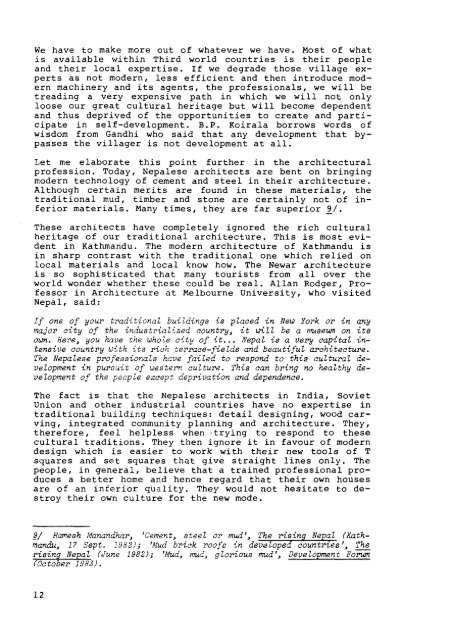Ifda dossier 47, May/June 1985
Ifda dossier 47, May/June 1985
Ifda dossier 47, May/June 1985
Create successful ePaper yourself
Turn your PDF publications into a flip-book with our unique Google optimized e-Paper software.
We have to make more out of whatever we have. Most of what<br />
is available within Third world countries is their people<br />
and their local expertise. If we degrade those village ex-<br />
perts as not modern, less efficient and then introduce mod-<br />
ern machinery and its agents, the professionals, we will be<br />
treading a very expensive path in which we will not only<br />
loose our great cultural heritage but will become dependent<br />
and thus deprived of the opportunities to create and parti-<br />
cipate in self-development. B.P. Koirala borrows words of<br />
wisdom from Gandhi who said that any development that by-<br />
passes the villager is not development at all.<br />
Let me elaborate this point further in the architectural<br />
profession. Today, Nepalese architects are bent on bringing<br />
modern technology of cement and steel in their architecture.<br />
Although certain merits are found in these materials, the<br />
traditional mud, timber and stone are certainly not of in-<br />
ferior materials. Many times, they are far superior 9/.<br />
These architects have completely ignored the rich cultural<br />
heritage of our traditional architecture. This is most evi-<br />
dent in Kathmandu. The modern architecture of Kathmandu is<br />
in sharp contrast with the traditional one which relied on<br />
local materials and local know how. The Newar architecture<br />
is so sophisticated that many tourists from all over the<br />
world wonder whether these could be real. Allan Rodger, Pro-<br />
fessor in Architecture at Melbourne University, who visited<br />
Nepal, said:<br />
If one of your traditional buildings is placed in New York or in any<br />
major city of the industrialized country, it will be a museum on its<br />
om. Here, you have the whole c* of it. .. Sepal is a very capital in-<br />
tensive country with its rich terrace-fields and beautiful architecture.<br />
The Nepalese professionals have failed to respond to this cultural de-<br />
velopment in pursuit, of uesterr. culture. This can bring no healthy de-<br />
velopment of the people except deprivation and dependence.<br />
The fact is that the Nepalese architects in India, Soviet<br />
Union and other industrial countries have no expertise in<br />
traditional building techniques: detail designing, wood car-<br />
ving, integrated community planning and architecture. They,<br />
therefore, feel helpless when -trying to respond to these<br />
cultural traditions. They then ignore it in favour of modern<br />
design which is easier to work with their new tools of T<br />
squares and set squares that give straight lines only. The<br />
people, in general, believe that a trained professional pro-<br />
duces a better home and hence regard that their own houses<br />
are of an inferior quality. They would not hesitate to de-<br />
stroy their own culture for the new mode.<br />
9J Ramesh Manandhar, 'Cement, steel or mud', The rising Nepal (Kath-<br />
mandu, 17 Sept. 1982); 'Mud brick roofs in developed countriesr, The<br />
rising Nepal (<strong>June</strong> 1982); 'Mud, mud, glorious mud' Development Forum<br />
(October 19831.
















